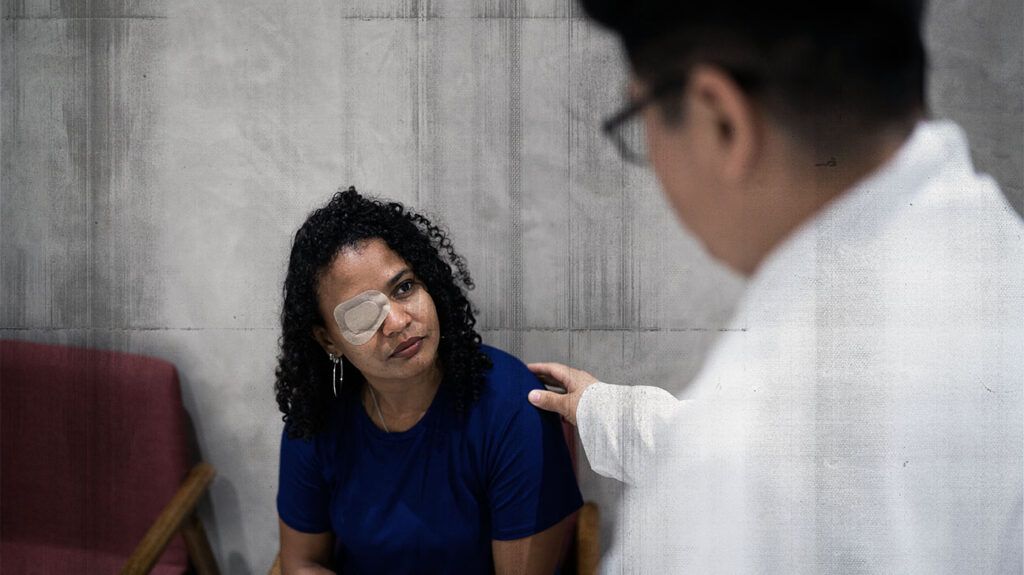Traumatic retinal detachment (TRD) is a serious eye condition that occurs when the retina, a thin layer of tissue at the back of the eye, pulls away from its regular position. Trauma or injury to the eye often causes this.
This article looks at the causes, treatment options, and outlook for those with TRD.

Retinal detachment
Eye injuries that can result in TRD include:
- Blunt trauma: A strong blow to the eye, such as an impact involving a ball or fist or during a car collision,
can cause the retina to detach. - Penetrating injuries: Objects piercing the eye, such as shards of glass or metal, can directly damage the retina.
- Chemical burns: Exposure to certain harsh chemicals can cause severe damage to the eye, potentially affecting the retina.
- Rapid acceleration or deceleration: Movements causing rapid changes in velocity, such as in car accidents, can exert force on the retina.
- Explosive or shock wave injuries: Explosions can generate waves of energy that can damage the eye’s internal structures.
Risk factors that can lead to eye trauma causing TRD
- Age: The risk increases with age, especially
after 50 years , due to changes in the vitreous gel. - Extreme nearsightedness, or high myopia: High myopia can lead to thinning of the retina, making it more susceptible to tears and detachment.
- Previous eye surgery: Surgeries, particularly cataract operations, can increase the risk of retinal detachment.
- Family history: A family history of retinal detachment increases an individual’s risk.
- Previous retinal detachment or tears: Individuals with retinal detachment or tears in one eye are at higher risk for detachment in the other.
- Certain eye conditions: Certain diseases, such as lattice degeneration, which leads to thinner retina patches, or other degenerative retinal disorders, can increase the risk of retinal detachment.
- Diabetes: Diabetes can lead to diabetic retinopathy, which can damage the retina’s blood vessels.
Common symptoms of TRD include:
- Flashes of light: These include the sudden appearance of flashing lights in the vision, which a person often reports as seeing stars or light flickers. These occur when the retina experiences stimulation due to pulling or movement.
- Floaters: These involve an increase in small specks or cobwebs that drift through the field of vision. These are due to tiny bits of debris that float in the vitreous and cast shadows on the retina.
- Blurred vision: A person’s vision may become blurry or distorted. Shapes and straight lines might appear wavy or bent.
- Partial loss of vision: A person may experience this as a curtain or shadow that moves across the field of vision. It often starts peripherally and progresses toward the center.
- Sudden loss of vision: In severe cases, there can be a significant or sudden loss of vision.
- Pain: Unlike nontraumatic retinal detachment, TRD might come with pain due to the injury causing the detachment.
Learn more about eye floaters.
Early diagnosis is critical for effective treatment and to maximize the chances of a successful recovery. If doctors suspect TRD, they will treat it as a medical emergency.
To diagnose TRD, a doctor will usually carry out the
- a medical and trauma history
- a visual symptom assessment
- a visual acuity test
- a pupil response test
- a slit lamp examination
- a dilated ophthalmoscopy
- ultrasound imaging
- optical coherence tomography
Treatment for TRD typically involves surgical intervention. The most common surgeries include:
- Laser surgery, or photocoagulation: This
involves using a laser to create small burns around the retinal tear. The scarring that results seals the retina to the underlying tissue, preventing further fluid from getting under the retina and worsening the detachment. - Cryopexy, or freezing treatment: This procedure freezes the area around the retinal tear,
causing a scar that helps secure the retina to the eye wall. - Pneumatic retinopexy: In this
procedure , doctors inject a gas bubble into the vitreous space inside the eye. They then position a person so the bubble presses against the detachment, helping to reattach the retina. - Scleral buckle: Doctors place a band around the eye to
gently push the walls of the eye against the detached retina. - Vitrectomy: This involves removing the vitreous gel and replacing it with a gas bubble or oil to hold the retina in place.
Learn more about scleral buckling.
The effectiveness of the TRD surgery often depends on proper postoperative care. This includes adhering to activity restrictions and positioning requirements, especially in pneumatic retinopexy, and attending all follow-up appointments.
The recovery process can vary depending on the type of surgery and the person’s overall eye health. It may take
Early intervention can significantly improve the likelihood of restoring vision and preventing permanent damage. An ophthalmologist or a retinal specialist can best
Below are answers to some frequently asked questions about TRD.
Can blunt force trauma cause retinal detachment?
TRD occurs when a sudden, direct impact to the eye or face applies significant pressure to the eye. When something hits the eye with force, the shockwave from the impact can reverberate through the eye’s structure. This
Can a person fully recover from retinal detachment?
The sooner the detachment undergoes treatment, the better the outcome. Prolonged detachment
Eye health resources
Visit our dedicated hub for more research-backed information and in-depth resources on eye health.
Traumatic retinal detachment can occur when there is an injury to the eye.
Anyone experiencing eye symptoms, such as a sudden increase in floaters, flashes of light, or a shadow over their field of vision after a trauma to the eye, needs to seek immediate medical attention. These could indicate retinal detachment.
Early diagnosis and treatment, usually involving surgery, are key to preserving vision.
